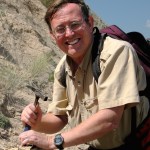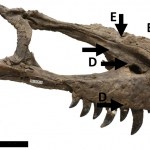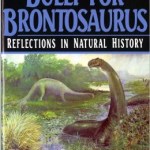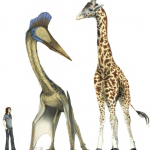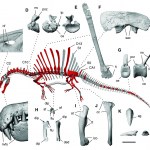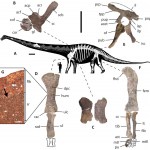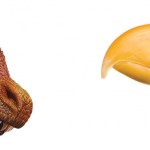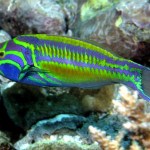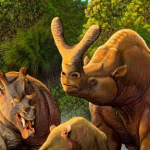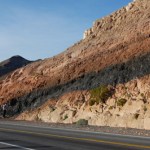dinosaurs
Ikonokast interviews Don Prothero.
Don Prothero is the author of just over 30 books and a gazillion scientific papers covering a wide range of topics in paleontology and skepticism. Mike Haubrich and I spoke with Don about most of these topics, including the recent history of the skeptics movement, the conflict and potentials between DNA and fossil research, extinctions and impacts, evolution in general, and the interesting projects Don is working on now.
The interview is here. Please click through and give this fascinating conversation a listen!
The number one rule of the Taphonomy Club is don't talk about marks on bones ... without placing them in context. Many marks on bones could have multiple causes, such as putative cut marks caused by stone tools on animal bones found on early hominid sites. In that case, hard sharp stony objects in the ground can cause marks that are hard to tell apart from stone tool marks. But when you find almost all the possible stone tool marks in the exact locations they would be if a hominid was butchering or defleshing the animal, then you can assert that that butchery or defleshing with stone tools…
Much is being made of Brontosaurus. Brontosaurus is a genus name for a large dinosaur, known to watchers of “Land Before Time” as “Long-Necks.” That generic name dates to the 19th century, but in the early 20th century it was eliminated as a proper Linnaean term and replaced with Apatosaurus. This made us sad. Most people discover dinosaurs and learn all about a select handful of the iconic ones, including Brontosaurus, then later learn that Brontosaurs is a bogus name. And become sad.
But perhaps this sadness is all for naught, because a very recent study seems to require the resurrection…
Pterosaurs: Natural History, Evolution, Anatomy by Mark P. Witton is a coffee-table size book rich in detail and lavishly illustrated. Witton is a pterosaur expert at the School of Earh and Environmental Sciences at the University of Portsmouth. He is famous for his illustrations and his work in popular media such as the film "Walking With Dinosaurs 3D."
The first pterosaur fossil was found in the late 18th century in the Jurassic Solnhofen Limestones, in Germany, the same excellent preservational environment that would later yield Archaeopteryx. They person who first studied it thought…
It is called Spinosaurus aegyptiacus but it sounds a bit more like Godzilla. Spinosaurus is a theropod dinosaur (that's the groups birds evolved within) found in what is now NOrth Africa, between about 112 and 97 million years ago. It was first discovered about one century ago, though those bones were destroyed during WW II. Spinosaurus aegyptiacus might be the only species of this genus, or there may be two. It is probably the largest carnivours dinosaur, up to 18 meters in length. Up top of the post is the picture from Wikipedia. Although the head looks a lot like a crock, you can see…
I'm sure you've heard. The most complete skeleton of a titanosaur, a newly named species, Dreadnoughtus schrani, is being reported from Argentina.
It is not a bird. I mention that because we've been talking about how birds are dinosaurs lately (see:"Honey, I shrunk the dinosaurs" and "Flying Dinosaurs: A new book on the dinosaur bird link.").
Dreadnoughtus schrani is a sauropod. Brontosaurus, if it existed, would be a sauropod. These are the dinosaurs with the little heads, long necks, and long tails. In cartoons they are sometimes called "long-necks." Dreadnoughtus schrani is, as…
Flying Dinosaurs: How Fearsome Reptiles Became Birds by science writer John Pickrell is coming out in December. As you know I've written a lot about the bird-dinosaur thing (most recently, this: "Honey I Shrunk the Dinosaurs") so of course this sounded very interesting to me. In a way, Pickrell's book is a missing link, in that he writes a lot about the history of paleontology associated with the discovery, undiscovery, and rediscovery of the early bird record and the dinosaur link.
Birds have rewritten dinosaurs. Not all dinosaurs are directly related to birds, but a large number of them…
For the first time, researchers have transformed induced pluripotent stem cells (iPSCs) into specialized bladder cells. Meanwhile the development of iPSCs from normal cells has been shown to depend on two proteins necessary for the induction of a glycolytic state. In order to make iPSCs, researchers have previously needed to collect significant amounts of skin, bone marrow, or blood from a donor, but researchers have demonstrated a new method that requires only a single drop of blood. In the future, you may be able to prick your finger, send a drop of blood to the lab, and have them…
You all know Don Prothero. He is an active member of the Skeptics and Science Blogging community. He is the author of several books, one of which you are totally supposed to own and if you don't it's kinda lame: Evolution: What the Fossils Say and Why It Matters. It occurred to me today that I never produced a formal review of one of Don's other books that I really enjoyed: Greenhouse of the Dinosaurs: Evolution, Extinction, and the Future of Our Planet. The reason for my skipping that review is that I had a radio interview with Don during which we discussed the topic as some length.…
Every once in a while Everything is Terrible has a fun denialism-overlap as they show some ad for a terrible piece of quackery, or in this case a great cut of Ken Ham speaking nonsense to a group of very unfortunate children. This is child abuse. Not the creationism bit, but the embarrassingly-shoddy job he does presenting his evidence which seems to consist of poorly-drawn cartoons of men standing next to dinosaurs and an overhead projector.
This is an enhanced version (with some upgraded images and text) of an article I first wrote over two years ago. It is just as valid today as it was back then, only today, I have a special offer to go with it. Next week, a bunch of cosmologists and myself are getting together and all writing about dark energy. And I want you to have your say.
So at the end of this post, ask your dark energy questions. Ask anything and everything you ever wanted to know about dark energy. I'll choose the best one (or, space & time permitting, more than one) and write a special post on it for you then.…
Study hard and get this guy's job:
I love that book, but when I was a kid they didn't have dinosaurs yet.
... from the National Center for Science Education.
Click the picture to get the PDF of Darwin's Universe: Evolution from A to Z
.
The Triassic is old. This book is new. That is a hard to beat combination.
Let's see ... The Triassic is about here:
(You can also look it up in this PDF file supplied by the USGS.
It is situated between two major extinction events, and is especially interesting because it is during this period that modern day ecological systems and major animal groups took a recognizable form. The preceding Permian, if contrasted with modern day, would form a very stark contrast while the Triassic would be at least somewhat more recognizable.
But of course the Triassic was in many ways distinct,…
Earlier this week, there was some interesting discussion of science communication in the UK branch of the science blogosphere. I found it via Alun Salt's "Moving beyond the 'One-dinosaur-fits-all' model of science communication" which is too good a phrase not to quote, and he spun off two posts from Alice Bell, at the Guardian blog and her own blog, and the proximate cause of all this is a dopey remark by a UK government official that has come in for some justifiable mockery.
Bell and Salt both focus on the narrowness of the "dinosaurs and space" approach-- a reasonably representative quote…
I'm still playing catch-up after my week in the desert, so I've seen a lot of articles I've wanted to mention ... but a certain other volcano has taken up a lot of my time. However, I will attempt to make amends for that now.
By the way, would you believe Ubehebe Crater was closed? How do they close a volcano, anyway? However, I did get a great snap of a welded tuff on the road outside of Shoshone, CA.
A strongly welded tuff near Shoshone, CA. The dark interior is remelted volcanic ash/tephra surrounded by less welded pink tuff with abundant pumice clasts. Denison student David Sisak is on…
The Not Exactly Pocket Science experiment continues after the vast majority of people who commented liked the pilot post. I'm really enjoying this, for quite unexpected reasons. It's forcing me to flex writing muscles that usually don't get much of a workout. Writing short pieces means being far more economical with language and detail than usual. It means packing in as much information as possible while still keeping things readable. And it means blitz-reading papers and writing quickly without losing any accuracy.
One quick note before the good stuff: last time, a few people suggested that…
Hold your arms out with your palm oriented vertically, as if you were trying to shake someone's hand. Now without moving your forearm, bend your hand downwards towards the floor. Unless you are freakishly flexible, you will only have managed to a measly acute angle. But if you were a bird, you could bend your wrist so that your hand pointed back towards your body. These incredibly flexible wrists allow birds to fold their wings and they help with flying. And many dinosaurs could do something similar.
Many older depictions of small raptors, including the Jurassic Park films, have them…
Snakes have been around for nearly 100 million years and scientists have found many fossils of extinct species. But this astonishing specimen is different. This serpent is Sanajeh indicus. It is sitting in a dinosaur nest and its coils surround three eggs and the body of a hatchling.
There are many reasons to think that this prehistoric tableau represented a predator caught in the act of hunting, rather than a mash-up of unconnected players thrown together by chance. The snake is perfectly posed, with its head resting atop a coil and its body encircling a crushed egg. All the pieces are…
tags: evolutionary biology, paleontology, taphonomy, plumage color, feathers, color, melanin, eumelanin, phaeomelanin, dinosaurs, theropod, paravian, avialae, fossils, Anchiornis huxleyi, ornithology, birds, researchblogging.org,peer-reviewed research, peer-reviewed paper
New research reveals that recently-described 155-million-year-old Anchiornis huxleyi,
a woodpecker-like dinosaur the size of a modern-day domesticated chicken,
had black-and-white spangled wings and a rusty red crown.
Image: Michael DiGiorgio, Yale University [larger view]
Fig. 4. Reconstruction of the plumage color of…
